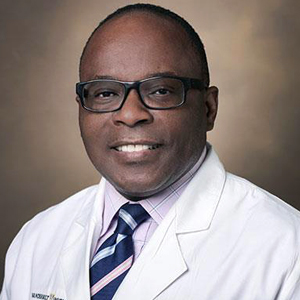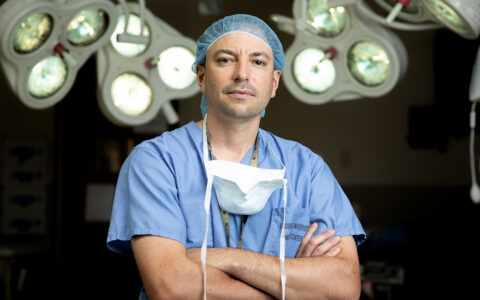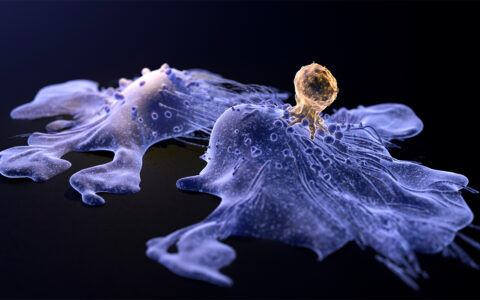Researchers at Vanderbilt University Medical Center are closely studying the value of the one validated cure for sickle cell disease (SCD) – hematopoietic stem cell transplants – in adults as well as children. Until now, studies of hematopoietic cell transplantation (HCT) have focused on pediatric populations.
While survival for children has improved in the last few decades, medicine has not made comparably significant progress in extending survival among adults, says Adetola Kassim, M.D., clinical director of the Adult Sickle Cell Transplant Program at Vanderbilt-Ingram Cancer Center and a coauthor of the largest systematic review to date that assesses allogenic HCT (allo-HCT) among patients of all ages.
“The current approach using related haploidentical (half-match) bone marrow transplant finally allows us an opportunity to abate the pervasive, progressive, age-dependent organ damage seen in individuals with sickle cell disease,” Kassim said. “It appears to be promising for patients of all ages.”
Overall Survival Is High
The meta-analysis appeared in Transplantation and Cellular Therapy, and evaluated evidence from 33 studies which together involved 2,853 patients. The researchers assessed the overall efficacy of allo-HCT in treating SCD and extended up to 11 years post-transplant.
“The current approach using related haploidentical (half-match) bone marrow transplant finally allows us an opportunity to abate the pervasive, progressive, age-dependent organ damage seen in individuals with sickle cell disease.”
“Unlike all other treatments, these transplants are curative. They completely kill the disease,” Kassim said.
“We found that allo-HCT is safe and effective, yielding pooled overall survival (OS) rates, for all ages combined, exceeding 90 percent,” he added. When separated by age groups, the authors wrote, “The pooled OS rates for pediatric patients and adult patients were high at 97 and 98 percent, respectively.”
For children, the disease-free survival (DFS) rate was 91 percent; acute graft-versus-host disease (aGVHD) developed in 26 percent of patients; and chronic graft-versus-host-disease (cGVHD) developed in 11 percent. The non-relapse mortality rate was 5 percent, and the graft failure (GF) rate was 3 percent.
For adults, the DFS rate was 90 percent; aGVHD developed in 7 percent of patients; and cGCHD developed in 1 percent. The non-relapse mortality rate was zero, and the GF rate was 14 percent. A 14 percent GF rate among adults causes concern, the authors stated, and merits further exploration, though it could be due in part to the limited adult sample available.
Disparities Limit Funding
The CDC estimates that about 100,000 Americans have SCD. One in 365 Black infants and 1 in 16,300 Hispanic-American babies is born with the genetic anomaly that causes it.
“We found that allo-HCT is safe and effective, yielding pooled overall survival (OS) rates, for all ages combined, exceeding 90 percent.”
Glaring disparities affect SCD funding, Kassim notes. For instance, in 2020, U.S. government-funded research averaged $812 per person living with SCD versus $2,807 per person living with cystic fibrosis, a genetic disorder mainly affecting Caucasians. Private foundations donate about $102 per person for SCD versus $7,690 per person for cystic fibrosis.
Kassim says disease complications can add to the financial burden. “The longer you live with this painful disease, the more complications you get,” he said. “We often see young people having strokes, some overt strokes and some silent ones, and then going on to develop neurocognitive deficits. People with sickle cell disease who lose executive function often cannot hold jobs or maintain relationships. They miss out on so much in life.”
At Vanderbilt, Kassim is working closely with Lori Jordan, M.D., an associate professor of pediatrics and pediatric neurology, and Manus Donahue, M.D., a professor of neurology, to better understand which individuals with sickle cell disease have increased stroke risk using novel imaging techniques.
The Need for Lower Cost Treatments
As promising as stem cell transplantation appears to be for both children and adults, it is expensive, so it’s probably not a viable option in low-income countries where sickle cell poses the biggest challenge, Kassim says.
“We often see young people having strokes, some overt strokes and some silent ones, and then going on to develop neurocognitive deficits.”
Encouragingly, a Vanderbilt team of investigators has shown that a low-cost drug, hydroxyurea, ameliorates the disease and thus might be a low cost strategy for stroke prevention in children with SCD. The drug may replace the expensive transplants, a finding of immense value for people in low- and middle-income countries.
All this research is aimed at averting progressive organ damage from SCD by pioneering therapies for a disease that disproportionately strikes underserved minority populations, Kassim explained. “A cure for sickle cell disease helps people improve their own standard of living. It addresses their overall health and wellbeing, and it can save the health care system enormous resources.”





